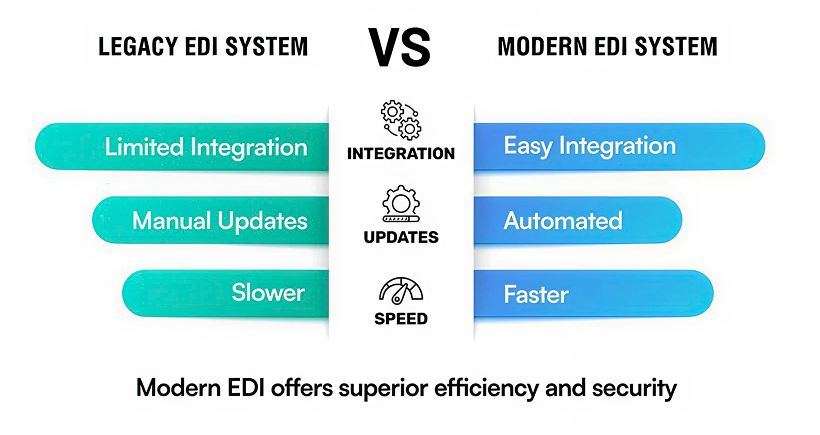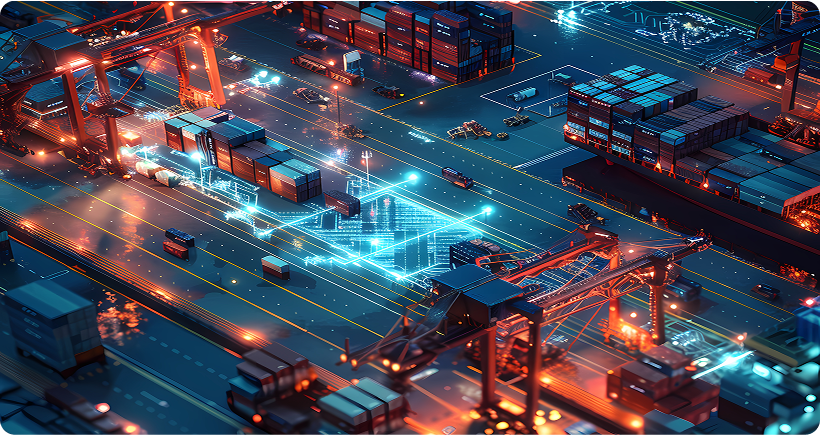
Have you ever wondered how much an outdated system is really costing your business? In today’s highly competitive logistics industry, the difference between success and failure often boils down to speed, efficiency, and accuracy. Companies that continue relying on old Electronic Data Interchange (EDI) systems are likely losing more than just time, they’re losing money, efficiency, and possibly their competitive edge. EDI has been the backbone of logistics for years, automating everything from order processing to shipment tracking. However, many businesses are still stuck using outdated EDI systems that are slow, inflexible, and prone to errors. These outdated systems may seem functional, but they are costing more than you think.
In this blog, we’ll dive into the hidden costs of sticking with outdated EDI and explain why upgrading to a modern system isn’t just a technical upgrade, it’s a critical business decision that could make or break your logistics operations.
The Role of EDI in Logistics: Driving Efficiency and Accuracy
EDI has transformed logistics by offering a digital way to exchange key documents like purchase orders, invoices, and shipment notices. In the past, these were exchanged manually via paper, fax, or phone calls, which were slow and error prone. Today’s EDI systems automate these tasks, greatly improving efficiency and reducing mistakes.
- Automates Key Processes: EDI automates the exchange of essential business documents, like purchase orders, shipping instructions, and invoices. This automation reduces manual data entry, speeding up order processing, shipment tracking, and invoicing. As a result, the supply chain operates more quickly and consistently.
- Improves Data Accuracy: With less manual intervention, EDI ensures more accurate data exchanges between partners. This is particularly crucial in logistics, where even small errors can lead to significant disruptions, such as missed shipments, delayed orders, or inventory discrepancies.
- Enhances Communication: EDI facilitates fast, real-time communication between carriers, shippers, and third-party logistics providers. This improved communication allows companies to respond more quickly to issues and make better-informed decisions based on up-to-date information.
- Ensures Regulatory Compliance: EDI helps businesses meet industry standards and regulatory requirements by ensuring that all electronic documentation is properly formatted and compliant with local, regional, and global trade laws. This reduces the risk of legal issues and fines
To better understand how EDI systems have evolved, let’s take a look at a side-by-side comparison of legacy vs. modern EDI systems.

The Evolution of EDI: Advancements in Technology
As technology advances, so does EDI in logistics. Older EDI methods, like X12 and EDIFACT, are being replaced by more modern systems that allow real-time data exchange and better integration with new technologies. Some key advancements include:
- API-Driven EDI: Application Programming Interfaces (APIs) have changed how data is exchanged in logistics. Unlike traditional batch-mode EDI, API-driven systems allow for real-time data exchange between platforms. This means logistics companies can instantly update transaction statuses, inventory levels, and shipment tracking, enabling quicker decision-making.
- AI and Machine Learning: Artificial Intelligence (AI) and machine learning are being integrated into EDI systems to enhance decision-making. These technologies analyze large volumes of data to predict trends, detect errors, and identify inefficiencies. AI can automate key decisions, such as selecting optimal shipping routes or pinpointing potential supply chain bottlenecks. Meanwhile, machine learning helps improve outcomes by learning from historical data.
- Blockchain-Enhanced EDI: Blockchain technology provides enhanced security and transparency for transactions. By integrating blockchain with EDI, logistics companies ensure that their data exchanges are tamper-proof and immutable. This significantly reduces the risk of fraud and disputes, making transactions more trustworthy.
- Cloud-Based EDI Solutions: Cloud computing has added scalability and flexibility to EDI systems. Cloud-based EDI platforms can easily handle growing transaction volumes and offer improved accessibility and uptime. This is especially valuable for businesses that need to access their systems remotely or support a global network of trading partners.
Here’s a simple timeline showing how EDI has evolved over the decades and how it has become an integral part of modern logistics.

Is Your EDI System Up to Date? A Quick Checklist
It’s not always easy to tell if your current EDI system is outdated, but here’s a checklist to help you assess whether it’s time for an upgrade:
- Real-Time Data Exchange & API Integration: Ensure your EDI system supports real-time communication through APIs. This feature allows information to flow seamlessly and instantly between trading partners, keeping all stakeholders up-to-date.
- Compliance with Modern EDI Standards: Check that your system is compatible with the latest EDI standards, such as X12, EDIFACT, TRADACOMS, and others. Adhering to these standards ensures smooth operations and consistent communication across the supply chain.
- Scalable Architecture: As your business expands, so will your transaction volume. A modern EDI system should be scalable, allowing you to easily manage increased data flow without performance issues or system crashes.
- Robust Security Measures: With increasing cybersecurity threats, it’s vital that your EDI system has strong security protocols. Look for features like encryption, access control, and other security measures to safeguard sensitive data.
- Cloud Compatibility: Cloud-based EDI solutions provide greater flexibility, reliability, and accessibility. This is especially important if your operations span multiple locations or require remote access across different time zones.
- Smooth EDI Map Migration: When upgrading, ensure that your EDI maps (which define how documents are exchanged) transition smoothly to the new platform. This will prevent data loss or disruptions during the migration process.
The Pitfalls of Legacy EDI: Challenges in an Evolving Market
While legacy EDI systems have been reliable for many years, they now face limitations in today’s fast-moving, technology-driven market. Sticking with outdated systems exposes businesses to several challenges:
- Limited Scalability: As transaction volumes grow, legacy EDI systems often struggle to keep up, leading to slow processing, system crashes, and delays that can disrupt the entire supply chain.
- Lack of Flexibility: Older EDI systems are rigid and hard to adapt to new business needs. This becomes an issue when working with modern partners who require different data formats or real-time integrations.
- Security Threats: Legacy systems often rely on outdated security protocols, making them more vulnerable to data breaches, hacks, and fraud.
- Manual Processes: Older systems may still need manual input for tasks like error correction, order entry, and reconciliation. This increases costs and the risk of human error.

Business Risks of Using Outdated EDI Systems in a Modern Logistics Landscape
Sticking with outdated EDI systems exposes companies to several business risks that can have a significant impact on their operations and bottom line:
- Slower Order Processing: Outdated EDI systems cause delays in transactions, disrupting the supply chain and leading to missed deadlines.
- Risk of Fines: Old systems may not meet current regulations, leaving your business vulnerable to penalties and legal issues.
- Data Errors: Legacy systems are prone to inaccuracies in shipment, invoicing, and inventory data, leading to operational inefficiencies.
- Missed Opportunities: Outdated EDI systems limit integration with modern platforms, preventing your business from tapping into new technologies and opportunities.
- Increased Maintenance Costs: Older systems often require frequent repairs, leading to higher IT costs and more downtime.
Modernizing EDI: Transitioning to the Latest Standards
Modernizing your EDI system involves several critical steps to ensure that your company remains competitive and compliant. Here’s a guide to making the transition:
- Assess Current System Limitations: Identify the limitations of your current system and understand where it is falling short in terms of scalability, flexibility, and security.
- Choose a Scalable, Cloud-Ready Solution: Select a modern, cloud-based EDI solution that supports real-time data exchange, is scalable, and offers the flexibility to adapt to new trading partner requirements.
- Migrate EDI Maps Smoothly: Ensure a smooth migration of your existing EDI maps to the new system. This step is critical to avoid disruptions and maintain data integrity during the transition.
- Implement API-Based Data Exchange: Move to API-based data exchange to enable real-time communication with trading partners and systems like ERP, TMS, and WMS.
- Leverage AI and Analytics: Use AI-powered analytics to proactively identify potential issues, optimize decision-making, and reduce the risk of errors.
- Ensure Compliance and Security: Ensure that the new system meets the latest industry standards and security protocols to protect sensitive business data.
How a Modern EDI System Transforms Your Logistics Operations
Upgrading to a modern EDI system can elevate your logistics operations in several ways:
- Speedy Transactions: Automated workflows streamline processes, meaning quicker order fulfilment and real-time shipment tracking—saving you time and improving customer satisfaction.
- Flawless Data Accuracy: With AI-driven validation, your data exchanges are error-free, ensuring that every transaction is spot-on and up-to-date.
- Effortless Integration: API connectivity ensures your EDI system seamlessly connects with ERP, TMS, and WMS platforms, resulting in smoother supply chain coordination and greater efficiency.
- Stronger Partner Collaboration: Real-time data sharing fosters stronger relationships with suppliers, customers, and third-party logistics providers, enabling faster decision-making and smoother operations.
- Cost Savings: By reducing manual tasks, cutting errors, and lowering IT maintenance, modern EDI systems help slash operational costs, making your business more profitable.
Conclusion
While outdated EDI systems might have worked in the past, they simply can’t keep up with the demands of today’s fast-paced logistics world. Upgrading to a modern, cloud-based, API-driven, AI-powered EDI solution is no longer a luxury, it’s a necessity for staying competitive. By making the switch, you’ll reduce costs, improve data accuracy, and strengthen your partnerships with suppliers and customers. This upgrade isn’t just about keeping up, it’s about investing in your business’s future and unlocking new growth opportunities.
Ready to elevate your logistics operations? Contact us today to explore how a modern EDI system can transform your business







